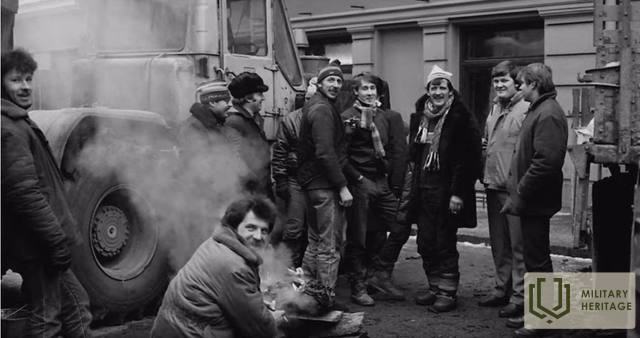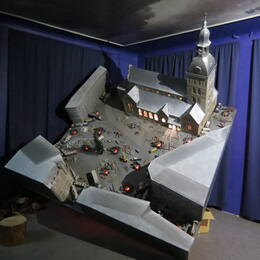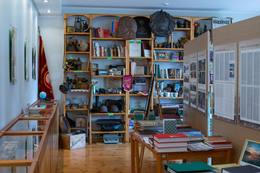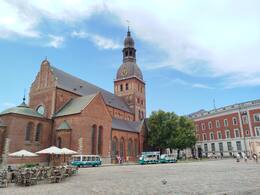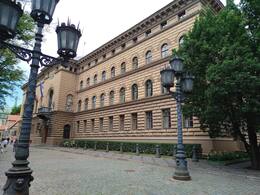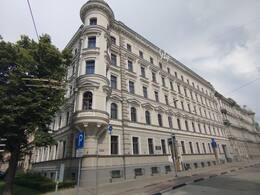Kocēniečio Tālavo Megnio prisiminimai apie įvykius 1991 m. barikadų Rygoje
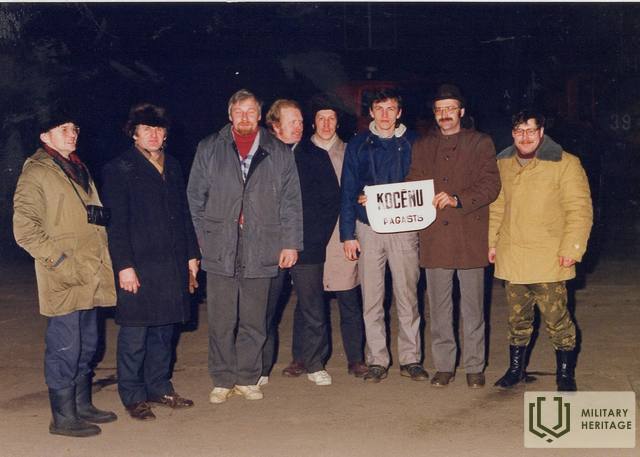
Kocēniečio Tālavo Megnio prisiminimai apie įvykius 1991-ųjų barikadų Rygoje.
„Sausio 13 d. apie 40 Kocėnų gyventojų organizuotai išvyko iš kolūkio į demonstraciją Rygoje autobusu „Laz“, kurį vairavo Vitalijus Spruktas, ir mikroautobusu „Latvija“, kurį vairavo Janis Grava.
Po demonstracijos, kai susitikome prie autobusų, kelis kartus per radiją girdėjome Latvijos liaudies fronto raginimą tiems, kurie gali, likti Rygoje ir ginti strategiškai svarbius objektus, kad būtų sunkiau juos užgrobti, panašiai kaip nutiko prie Vilnios televizijos. Šiuos kadrus matėme, kuriuos Podnieks nufilmavo prieš išvykdamas į Rygą.
Aš, Tālavas Megnis, sausio mėnesį pradėjau dirbti Kocėnų parapijos savivaldybėje žemės planuotoju, atsakingu už žemės reformos įgyvendinimą. Pasitarę tarpusavyje ir su kolūkio specialistais – vyriausiąja buhaltere Ruta Rozenberga, buhaltere Gaida Raga ir dispečere Liene Kūna bei 1-ojo rajono agronome Ilga Brusova, mikroautobuso „Latvija“ vairuotoju Jāniu Gravu ir kitais – nusprendėme, kad norintys liks Rygoje, atsiliepdami į Liaudies fronto kvietimą. Kolūkio kolegoms pasakiau, kad pirmadienį negaliu eiti į darbą, nes jei mūsų naujoji vyriausybė žlugs, žemės reforma tikrai neįvyks, bet jei ji užsitęs, neatvykimas į darbą bus atleistas.
Naktį iš sausio 13 į sausio 14 d. Rygoje likusios grupės vadovu buvo išrinkti Janis Grava – mikroautobuso „Latvija“ vairuotojas; Janis Olmanis – Kocėnų pradinės mokyklos muzikos mokytojas; Tālavs Megnis – Kocėnų valsčiaus matininkas, anksčiau ėjęs kolūkio „Kocēni“ apylinkės viršininko pareigas; Dainis Ābelītis – iš „Strautnieki“ namų, kolūkio darbininkas-vairuotojas; Juris Miķelsons; Uldis Rolmanis – tuo metu MRS (Miškų urėdijos) darbininkas-vairuotojas; Aivars Vīksne – statybininkas iš statybininkų brigados.
Kai kiti išėjo, mes savo mikroautobusu nuvažiavome iki Ministrų kabineto įėjimo, kieme iš Brīvības gatvės. Tada išlipome iš autobuso, nuėjome iki pagrindinio įėjimo, kur priekyje jau stovėjo du žmonės. Kalbėjomės, ką čia dabar veiksime su savo nuogu gyvenimu, ar maitinsime patrankas – juokėmės. Susipažinome, pirmieji du buvo vyrai iš Cėsių, nepamenu, kokie buvo jų vardai. Kartkartėmis ateidavo dar kas nors, sustodavo ir keli automobiliai, ir autobusas su demonstracijos žmonėmis, atrodo, jie buvo iš Adažų. Nusprendėme, kad nebežinome, ką daryti, bet kurį laiką stovėsime, pažiūrėsime, kas bus. Autobusas po kurio laiko išvažiavo, linkėdamas mums palaikymo.
Po kurio laiko prie mūsų grupės priėjo aktorė Dina Kuple ir dar viena moteris. Jos labai džiaugėsi, kad mes čia stovime, ir maldavo mūsų neišeiti ir padėti saugoti Rygą. Kad čia nesušaltume, jos paliko mums mažą balzaminį indelį, suvyniotą į laikraštį. Temo.
Po trumpo laiko prie mūsų, kaip studentų, priėjo du jaunuoliai, klausdami, iš kur esame, kas vyriausias arba grupės vadovas. Esame septyni žmonės iš Kocėnų, Valmieros rajone, su mikroautobusu „Latvija“, jei reikia, galiu būti ir grupės vadovu. Tada nuėjau su tais vaikinais prie jų „Žigulių“, jie tikriausiai buvo baltos arba gelsvos spalvos. Jie stovėjo Ministrų kabineto pastato gale, Laisvės paminklo pusėje, Baumano aikštėje. Susipažinome, bet nebepamenu mūsų vardų. Jų „Žigulyje“ buvo racija. Tada jie susisiekė su Liaudies fronto būstine ir pranešė, kad turi septynis alaus butelius ir vieną polšą ir gali gauti daugiau – supratau, kad tai septyni vyrai ir vienas transporto vienetas. Tie vaikinai nurodė man sustabdyti transporto priemones ir pakviesti žmones pasilikti prie šio objekto, o iš pradžių aplink visą pastatą suformuoti gyvąją grandinę. Jie taip pat paklausė, ar galime pamatyti, kas vyksta tarptautinėje telefono stotyje Dzirnavu gatvėje, ir ar esame pasiruošę imtis kitos užduoties. Atsakiau, kad padarysime viską, kas būtina. Tada jie išėjo, liepę man pačiam atvykti į šį automobilį, kai jie grįš čia, arba į kitą vietą gauti naujų užduočių. Autobuse nuolat klausėmės Liaudies fronto informacijos, kuri retkarčiais buvo transliuojama per radiją.
Vykdydami nurodymus, pradėjome daug aktyviau stabdyti automobilius ir kreiptis į žmones, kad jie pasiliktų ir, bent jau kaip liudininkai, ateityje pamatytų, kas čia vyksta. Žmonės paprastai reagavo, prie pastato ėmė gaišti laiką tiek Rygos gyventojai, tiek praeiviai. Iš autobuso, kuriuo važiavo demonstracijos dalyviai, išlipo keli jauni žmonės, atvykę iš Limbažių rajono, ir po poros valandų čia susirinko apie šimtą žmonių.
Palikę kitus narius ir autobusą prie Ministrų kabineto, mudu su Jāniu Olmaniu nuėjome iki telefono stoties pastato Dzirnavu gatvėje. Tuo metu Čaka gatvės gale Dzirnavu gatvę užblokavo didelis „KrAZ“ sunkvežimis su priekaba, ant kurio važiavo buldozeris T130. Gatvėje buvo nemažai žmonių. Priešingoje gatvės pusėje nuo telefono stoties iš rekonstruojamo ar griaunamo namo statybinių medžiagų spontaniškai buvo pastatyta užtvara. Dvi sumanios jaunos merginos, gimnazistės, galbūt studentės, negalėjo nuplėšti lentų nuo senos aukštos medinės tvoros ir sušuko mums su Jāniu: „Na, padėkite nugriauti tvorą, ką jūs čia žiūrite!“
Nepraėjo nė penkios minutės, kai ūkis jau buvo kitoje gatvės pusėje kartu su visokiausiu šlamštu, senomis lovomis, statinėmis, kėdėmis ir spintomis. Kai nebeliko ką nešti, grįžome pėsčiomis prie Ministrų kabineto pas savo grupę. Netrukus atvažiavo keli sunkvežimiai su žvyru ir skalda, o vėliau – „Ural“ sunkvežimis – miškovežis su rąstais.
Netrukus sutartoje vietoje vėl atvažiavo „Žigulis“ su Liaudies fronto vaikinais. Priėjęs prie jų, įsėdau į automobilį. Jaunuoliai paklausė, ar galėtume savo mikroautobusu išvažiuoti pažiūrėti, kas vyksta prie kai kurių sovietų karinių dalinių. Pasakiau, kad tikrai galime, tik reikia pasikalbėti su kitais. Jie pasakė, kad atsiveš dar vieną žmogų ir kad turėtume ruoštis važiuoti.
Grava Jānis, žinoma, buvo pasiruošęs eiti, ir po kelių minučių studentai atsivedė du maždaug trisdešimties metų amžiaus žmones ir raciją. Galbūt vienas prisistatė Druvio vardu. Dalis mūsų grupės apsistojo prie Ministrų kabineto, o mes važiavome Juglos kryptimi iki dabartinės Krustabaznīcas gatvės, tada Viskaļu ir Ezermalas gatvėmis. Tada Mežos ir Viesturos prospektais iki OMON bazės Vecmilgravi mieste. Druvis periodiškai pranešdavo savo štabui apie matytas armijos transporto priemones, BTR (šarvuočius), jų skaičių, markes, juose matytus kareivius ir judėjimo kryptis. Matyt, kariniai daliniai buvo sustiprintame budėjime, nes keliose vietose gatvėse matėme sargybinius su kulkosvaidžiais ant pečių.
Iš Vecmilgravi per centrą nuvažiavome iki Salu tilto, kad įvertintume situaciją Zaķusaloje esančiame Televizijos centre, kur buvo pakviesti Kuržemės gyventojai. Salu tiltas ir Televizijos centras jau buvo visiškai užblokuoti – automobiliais, sunkia žemės ūkio ir statybine technika, gelžbetonio blokais. Kai kur gatvėje buvo suvirinti prieštankiniai ežiai. Per tiltą buvo galima pereiti labai sunkiai ir tik viena eismo juosta. Buvo daug barikadų dalyvių ir Nacionalinės gvardijos. Mus kelis kartus stabdė ir kartais gana agresyviai klausinėjo, kas mes esame ir kur važiuojame. Pasiaiškinome ir maždaug per valandą perėjome tiltą. Tada grįžome į centrą per Akmens tiltą. Druvis padėkojo mums per raciją ir savo kolegoms už pagalbą ir pasakė, kad toliau eis patys. Kai kurie iš mūsų nuėjome iki Aukščiausiosios Tarybos pastato, dabar Saeimos, Jėkabo gatvėje. Senoji Ryga jau buvo visiškai užbarikaduota sunkia technika, kuri buvo taip glaudžiai suspausta, kad vienu metu galėjo išlipti tik vienas, kad pasiektų priekį. Vieną siaurą gatvelę visiškai užblokavo didžiausias ratinis traktorius T-700, kurį buvo sunku pravažiuoti. Jėkabos gatvėje buvo kraunami gelžbetonio blokai, sudarantys labirintą. Visa tai matydamas, įsitikinau, kad visi kartu esame didžiulė, nesuvokiama jėga. Nors neturime ginklų ir esame tik „patrankų mėsa“, visų mūsų vienybė yra nuogų gyvybių ir įrangos tvirtovė, kurios užėmimui reikėtų panaudoti milžinišką, precedento neturinčią, brutalią, kruviną jėgą prieš taikius gyventojus, kaip buvo Kinijoje Pchenjano aikštėje prieš studentus prieš keletą metų, kur jie buvo tempiami tankų grandinėmis. Kas galėjo duoti tokį įsakymą – pradėti karo veiksmus prieš neginkluotus žmones? Neįmanoma.
Todėl vėliau sovietų funkcionieriai sugalvojo išpuolį prieš Vidaus reikalų ministeriją, kuri nepalaikė Komunistų partijos pastangų išsaugoti sovietų valdžią, bet dvasia ir įsitikinimu buvo su barikadų dalyviais.
Grįžę prie Ministrų kabineto, likę grupės nariai pamatė, kad šis pastatas yra palyginti mažiausiai apsaugotas, nes yra pakankamai didelis, įsikūręs plačių gatvių viduryje, o dar keli atvykę sunkvežimiai nesudarė didelių kliūčių smurtiniam pastato užgrobimui, nes tik Brīvības gatvės pusė buvo šiek tiek užblokuota, o iš Elizabetės ir Tērbatos gatvių pusių buvo tik keli lengvieji automobiliai ir taip pat mūsų mikroautobusas „Latvija“.
Tada, pasitarę, nusprendėme, kad turėtume pakviesti mūsų kocėnus su jų dideliais T150 traktoriais. Nuėjau kažkur netoli kino teatro „Pionieris“ arba „Rīga“ ir iš taksofono, galėjo būti apie 23.00–24.00 val., paskambinau Vitautui Staņam, kolūkio „Kocēni“ vyriausiajam inžinieriui, nes žinojau, kad jis palaikys šį renginį. Trumpai aprašęs situaciją Rygoje, pasakiau, kad jie turėtų stengtis suorganizuoti į Rygą kuo daugiau traktorių, be kurių jie galėtų apsieiti, kad būtų užtikrinta gamyba. Pasiūliau jiems pasiūlyti pavėžėti mūsų slidinėjimo komandos raiteliams, broliams Juriui ir Jāniui Caunėsams, Gunčiui Skrastiniui, Gunčiui Zēvaldui, Juriui Bečeriui ir kitiems, nes buvau jų treneris ir žinojau, kad jie neatsisakys ir kad jais galima pasikliauti bet kokioje situacijoje. Tada grįžome į autobusą ir, supratę, kad turime laukti ryto ir pastiprinimo, šnekučiavomės ir šildėmėmės Dinos Kuplės paliktu balzamu. Kažkur Vērmaņdārzio pusėje jau buvo užkurta nedidelė laužavietė, malkų buvo likę nedaug. Naktis buvo labai drėgna ir šalta.
Po vidurnakčio troleibusai nevažiavo į garažus, o stovėjo arti vienas kito aplink visą Ministrų kabineto pastatą, kartais dviem eilėmis, kur nebuvo kitų transporto priemonių. Iškart po aštuonių vėl paskambinau vyriausiajam mechanikui, paklausiau, kokia situacija ir ar galime tikėtis kokios nors technikos iš Kocėnų. Vytautas atsakė, kad kai kurie iš jų jau pildomi degalais, planuojami darbai, kad potencialūs keleiviai galėtų nuvykti į Rygą nesutrikdydami gamybos. Taip pat informavau jį, kad Rygoje nėra malkų, kurias būtų galima kūrenti laužuose, ir įsakiau, kad visi traktoriai, prieš išvykdami, nuvažiuotų į lentpjūvę ir pakrautų rąstus – rąstų pjovimo atliekas, kurių tuo metu ten stovėjo dideliais kiekiais ir kurios buvo našta gamybai.
Sausio 14-osios rytą trys ar keturi T150 traktoriai su priekabomis išvyko į Rygą, prieš tai į pašiūrę pakrovę malkų. Toliau pateikiamas barikadų dalyvių, atvykusių į Rygą su kolūkio technika, sąrašas.
Kaip ir maniau, apie vidurdienį Juris Caune atvyko į Rygos Ministrų kabinetą su MTZ 82 traktoriumi ir trimis T150 traktoriais su priekabomis. Kartu su jais atvyko Jānis Caune, Guntis Skrastiņš, Juris Bečers, taip pat Guntis Zēvaldas, Guntaras Konāns, Juris Tīlikas arba Andis Bērziņš. Traktorių priekabos, kaip jau minėjau, buvo pakrautos malkomis laužams. Po trumpo laiko traktoriai buvo pasiųsti blokuoti Dzirnavu gatvę prie telefono stoties. Visų barikadų metu čia stovėjo ir mūsų kolūkio technika. Kurį laiką ant Brasos tilto, kitą dieną po pirmųjų tragiškų įvykių, buvo tik Guntis Škrastiņš su savo traktoriumi. Per riaušių policijos išpuolį ten taip pat buvo pastatytas A. Bāliņš iš Kočenių su savo sunkvežimiu „Kamaz“.
Kad sušiltume ir išsikeptume dešrelių, tiesiog gatvėje tarp traktorių užkūrėme laužą. Vėliau kažkas buvo atnešęs arba parnešė didelį ketaus puodą, kuriame virė sriubą ar kokią nors košę. Kiekvieną dieną iš kolūkio pamainoms atvykdavo nauji barikadų dalyviai. Pamenu, kad vėliau atvyko Jānis Krīgersas, Aivaras Ragas su dukra Sanita, Jānis Jėgersas, Juris Fridvaldsas, Kārlis Koķis, Vitalijs Bečersas, Edgaras Bečersas, Uldis Lukssas, Jānis Trēziņšas ir kiti. Žinoma, sunku visus prisiminti. Iš kolūkio rezervų buvo paimtos ir dujokaukės. Dėl viso pikto.
Draugiškas ir palaikantis aplinkinių gyventojų, nepriklausomai nuo tautybės, požiūris į mūsų buvimą Rygoje ir mūsų apsaugą buvo fantastiškas. Daugelis prieidavo prie mūsų ir mus drąsindavo, atnešdavo termosus arbatos ir cigarečių. Pamenu, vieną vakarą viena rusė man atnešė didelę lėkštę šiltų, ką tik iškeptų blynų ir butelį degtinės, pirktos su kuponais, nes pati negerdavo, bet mums būtų naudinga naktį būti šilčiau. Ji taip pat daug papasakojo apie savo gyvenimą ir kodėl džiaugiasi laisva Latvija.
Pamenu, vieną dieną, nepamenu, kuris iš traktoriuose sėdinčių žmonių pastebėjo, kad du vyrai pačiame jėgų žydėjime lėtai vaikšto tarp traktorių, viską stebėjo, kalbėjosi, vienas kartkartėmis fotografavo. Tiesiog įtartini tipai. Manėme, kad Čekos agentai renka informaciją apie prieigą prie telefono stoties. Priėjome ir pradėjome juos erzinti, kas tie šnipai, nes jie nesielgė kaip korespondentai ar tiesiog susidomėję žmonės, kuriuos daugelis jau buvo matę su kameromis. Po gana ilgų diskusijų supratome, kad šie stebėtojai taip pat buvo mūsų, bet su kitokia perspektyva ir noru įamžinti šią situaciją ar istorinę akimirką.
Po įtemptos pirmosios nakties, kitos naktys buvo gana nuobodžios ir monotoniškos. Kai kuriomis naktimis taip pat buvo gana šalta, atrodo, net iki maždaug -15°. Tada nuėjome į netoliese esantį kiną ir žiūrėjome filmą, nes filmai buvo rodomi nuolat, regis, visą parą ir nemokamai. Dvi naktis porai valandų taip pat buvau grįžęs pasėdėti ir sušilti Kupolo bažnyčioje. Ten nebuvo taip šilta laipsniais, bet ten tvyrojusi ramybė neapsakoma. Trumpa meditacija šalčiausiame, labiausiai saugomame ramybės uoste suteikė man jėgų, tikėjimo ir pasitikėjimo, kad einame teisingu keliu. Vienas bažnyčios kampas buvo paruoštas sužeistiesiems priimti. Atrodo, kad ten buvo kelios dešimtys neštuvų, tvarsčių ir vaistų.
Taip pat pamenu, kad vėliau prie Ministrų kabineto buvo įrengtas didelis ekranas, kuriame nuolat buvo rodoma CNN informacija apie įvykius Latvijoje, Kuveite, „Audrą dykumoje“ ir kitur pasaulyje.
Sausio 20-osios vakarą, kai buvo paimta Vidaus reikalų ministerija, kitu kolūkio autobusu išvykau į Valmierą. Norėjau grįžti namo pas šeimą sušilti ir nusiprausti po dušu. Mano žmona Gunta jau buvo išvykusi su vaikais į Valmierą aplankyti mamos, nes jos gimtadienis buvo sausio 20-ąją. Taip pat nuėjau tiesiai pas sukaktuvininkę. Kai apie devintą vakaro įėjau į butą, prisimenu, kad per televizorių jau rodė kadrus iš Rygos centro, kur vyko išpuolis prieš Vidaus reikalų ministeriją, kaip neštuvais buvo nešami sužeistieji Gvido Zvaigzne ir Andris Slapiņš. Mano uošvė Hedviga verkė. Mano uošvis Ēvaldas, senas kareivis, susimąstęs tylėjo. Jaučiau du jausmus: viena vertus, džiaugsmą, kad esu namuose, šiltai su šeima, bet, kita vertus, kad nesu ten, Rygoje, tarp barikadų. Kuo visa tai baigsis? Kitą dieną kitu autobusu važiavome į Rygą...“
Tālavų Megnų prisiminimai
Susijusi laiko juosta
Susijusios vietos
1991 m. barikadų muziejus
Muziejus yra Senojoje Rygoje, netoli Rygos katedros. Jis buvo įkurtas 2001 m., siekiant išsaugoti istorinius 1991 m. įvykių Latvijoje įrodymus. Taip pat galima virtualiai aplankyti muziejų. 1991 m. sausį Lietuvoje Sovietų armija apšaudė prie Vilnios televizijos bokšto susirinkusius žmones ir tankais įvažiavo į minią. Reaguodama į šiuos įvykius, Rygoje buvo surengta apie 500 000 žmonių demonstracija, kuria siekta parodyti paramą lietuviams ir Latvijos žmonių pasirengimą tęsti kovą už Latvijos nepriklausomybę. Siekdami užkirsti kelią panašiems įvykiams Latvijoje, gyventojai pradėjo statyti barikadas siaurose Senosios Rygos gatvėse, kad užkirstų kelią galimiems Sovietų armijos išpuoliams prieš barikadų gynėjus. Šios barikados taip pat buvo kuriamos įvairiuose strateginiuose objektuose ne tik Rygoje, bet ir visoje Latvijoje. Ginant barikadas dalyvavo apie 50 000 žmonių iš visos Latvijos. Barikados buvo populiarus judėjimas, padėjęs atgauti Latvijos nepriklausomybę. Tai puikus nesmurtinio pasipriešinimo pavyzdys viso pasaulio istorijoje.
Vaidavos parapijos kraštotyros nuolatinė ekspozicija
Įsikūręs Vaidavos kultūros ir amatų centre.
Eksponuojama paroda, skirta 1949 m. trėmimų atminimui, taip pat Vajdaviečių dalyvavimui Rygos barikadose 1991 m. sausį. Parodoje taip pat eksponuojami pasaulinių karų įrodymai (daugiausia spausdinta medžiaga).
Gamtos ir istorijos objektai, dvarai, švietimo istorija, kultūra, žymūs žmonės, kolūkio laikų medžiaga, namų apyvokos rakandai, banknotai, laikraščiai, žurnalai apie Vaidavos parapiją.
Domo aikštėje Senojoje Rygoje
Domo aikštės svarbą Atbudimo laikotarpiu daugiausia lėmė dvi aplinkybės – ji buvo įsikūrusi visai šalia Latvijos SSR Aukščiausiosios Tarybos pastato, taip pat tai, kad aikštėje yra Latvijos radijo pastatas. Domo aikštėje buvo rengiami įvairūs veiksmai, kurių metu Aukščiausiajai Tarybai buvo keliami reikalavimai, pavyzdžiui, 1989 m. liepos 26 d. Latvijos darbo federacija surengė mitingą, kuriame dalyvavo 60 000 žmonių, reikalaudama, kad Aukščiausioji Taryba priimtų Suvereniteto deklaraciją. Būtent šiame mitinge buvo iškeltas tuo metu populiarus šūkis „Kažkas praeityje, bet laisvoje Latvijoje“.
Kupolo aikštė buvo pagrindinė barikadų gynėjų susibūrimo vieta 1991 m. sausį, saugojusi Aukščiausiąją Tarybą ir Radijo rūmus. Barikadų gynėjai šildėsi prie laužų. Jie taip pat apsistojo Radijo rūmuose ir Kupolo bažnyčioje. Bažnyčioje buvo įrengta pirmosios pagalbos stotis, vyko pamaldos. Vakarais aikštėje improvizuotoje scenoje koncertavo populiarios roko grupės. Kiekvienais metais Kupolo aikštėje rengiami barikadų minėjimo renginiai.
Netoli Domo aikštės, Krāmu gatvėje 3, yra 1991 m. barikadų muziejus. 2018 m. sausio 13 d. Domo bažnyčioje buvo atidengtas menininkų Krišo ir Dzintaro Zilgalvjų vitražas „Su aistra už laisvą Latviją“ – dedikacija 1991 m. barikadoms ir Latvijos nepriklausomybei.
Parlamento rūmai (Saeima)
Buvusiuose Vidžemės riterių namuose nuo 1922 m. įsikūręs Latvijos parlamentas. Sovietų okupacijos metu čia buvo įsikūręs pseudoparlamentas – Latvijos SSR Aukščiausioji Taryba. 1990 m. kovo mėn. vykusiuose Aukščiausiosios Tarybos rinkimuose pagrindinis klausimas buvo Latvijos valstybinės nepriklausomybės atkūrimas. Tai buvo padaryta laikantis Latvijos liaudies fronto pozicijos, kuri teigė, kad realiau tai padaryti pasinaudojant esamomis SSRS valdžios struktūromis. Norint laimėti kvalifikuotą balsavimą Aukščiausiojoje Taryboje, reikėjo 134 balsų.
1990 m. gegužės 4 d. Latvijos TSR Aukščiausioji Taryba priėmė deklaraciją „Dėl Latvijos Respublikos nepriklausomybės atkūrimo“. Už jos priėmimą balsavo 138 deputatai, 1 susilaikė, tačiau 57 deputatai, pasisakę už Latvijos likti SSRS sudėtyje, balsavime nedalyvavo. Priėmus deklaraciją, Latvijos teritorijoje buvo atkurta 1922 m. Konstitucija, tačiau iki naujos Konstitucijos redakcijos priėmimo jos galiojimas buvo sustabdytas, išskyrus pirmuosius tris Konstitucijos straipsnius. Toks pereinamasis laikotarpis buvo nustatytas iki Latvijos Respublikos Saeimos sušaukimo. Gegužės 4 d. minima Latvijos Respublikos nepriklausomybės atkūrimo diena.
1990 m. gegužės 15 d. nepriklausomybės priešininkai, pasitelkę civiliais drabužiais apsirengusius karo kadetus, bandė užimti Aukščiausiąją Tarybą, tačiau spontaniškai susiorganizavę Politechnikos instituto ir Kūno kultūros instituto studentai atrėmė puolimą. Antrąjį bandymą pulti Aukščiausiąją Tarybą sustabdė milicija (OMON dalinys, kuris 1990 m. birželį atsisakė paklusti Latvijos Respublikos vyriausybei ir tapo pagrindine nepriklausomybės priešininkų smogiamąja jėga).
Aukščiausioji Taryba 1991 m. sausį buvo vienas svarbiausių barikadų apsaugos taškų. Jos prieigos buvo aptvertos gelžbetonio blokais, ir šios apsauginės konstrukcijos ten buvo iki nesėkmingo perversmo Maskvoje 1991 m. rugpjūčio 19–21 d. Sovietų Sąjungos desantininkams ir OMON kovotojams nepavyko užimti Aukščiausiosios Tarybos, o jos deputatai tęsė savo darbą. Rugpjūčio 21 d., 13 val., keturi OMON šarvuočiai įžengė į Domo aikštę ir liko ten iki 14 val. 10 min., bandydami įbauginti deputatus, kurie tuo metu (13 val.) priėmė Konstitucinį įstatymą dėl Latvijos Respublikos valstybinio statuso (už balsavo 111 deputatų, 13 – prieš). Tai panaikino 1990 m. gegužės 4 d. nustatytą pereinamąjį laikotarpį, skirtą de facto atkurti valstybės valdžią Latvijos Respublikoje, ir Latvija atgavo visišką nepriklausomybę. 2007 m. prie Saeimos rūmų Jėkabos gatvėje buvo atidaryta 1991 m. sausio barikadų atminimo vieta, o 2000 m., minint Latvijos Respublikos nepriklausomybės atkūrimo 30-ąsias metines, prie pagrindinio Saeimos įėjimo buvo įrengta atminimo lenta su užrašu: „Šiame pastate 1990 m. gegužės 4 d. Aukščiausiosios Tarybos deputatai priėmė deklaraciją dėl Latvijos Respublikos nepriklausomybės atkūrimo“.
Bastejkalns rajonas Rygoje
Bastėjokalnio apylinkėse yra keletas barikadų laikų memorialinių vietų. Aikštė, esanti Smilšu ir Torņa gatvių sankryžoje, priešais Parako bokštą, 2016 m. buvo pavadinta 1991 m. Barikadų aikšte. Čia dislokuota sunkioji technika saugojo Senąją Rygą nuo įsiveržimo į strategiškai svarbią vietą. Netoliese esančiame Latvijos karo muziejuje buvo įsikūręs pirmasis barikadų stulpas.
1991 m. sausio 20 d. Bastejkalns apylinkėse įvyko OMON išpuolis prieš Vidaus reikalų ministeriją, nusinešęs kelių žmonių gyvybes. Kanalo pakrantės žalumose, priešais Bastejkalnsą, tose vietose, kur aukos buvo mirtinai sužeistos, pastatyti memorialai – akmenys milicijos leitenantui Vladimirui Gamanovičiui, vidaus reikalų departamento inspektoriui Sergejui Kononenko, Rygos kino studijos direktoriui Andriui Slapiniui, moksleiviui Edijui Riekstiniui ir nušauto vaizdo operatoriui Gvido Zvaigznesui, žuvusiems vasario 5 d. Yra versija, kad šauliai buvo ne tik OMON nariai, bet ir kokia nors „trečioji jėga“ – arba iš specialiojo dalinio „Alfa“, arba SSRS valstybės saugumo komiteto darbuotojai iš Maskvos, kurie išprovokavo OMON išpuolį prieš Vidaus reikalų ministeriją.
Kanalo pakrantės soduose taip pat pastatytas atminimo akmuo 1991 m. rugpjūčio 19 d. aukai Raimondui Salminiui, kurį riaušių policija nušovė netoli Rygos miesto policijos nuovados pastato Aspazijas bulvaro ir 13-osios gatvės sankryžoje. 2014 m. prie buvusio Vidaus reikalų ministerijos pastato Rainio bulvaro ir Reimersos gatvės kampe buvo įrengta atminimo lenta, skirta 1991 m. sausio 20 d. išpuolio prieš Vidaus reikalų ministeriją aukoms atminti.




